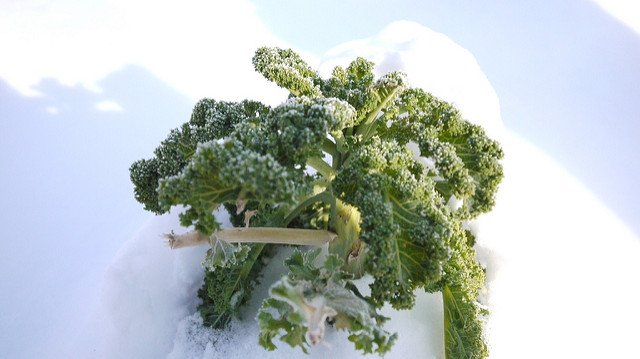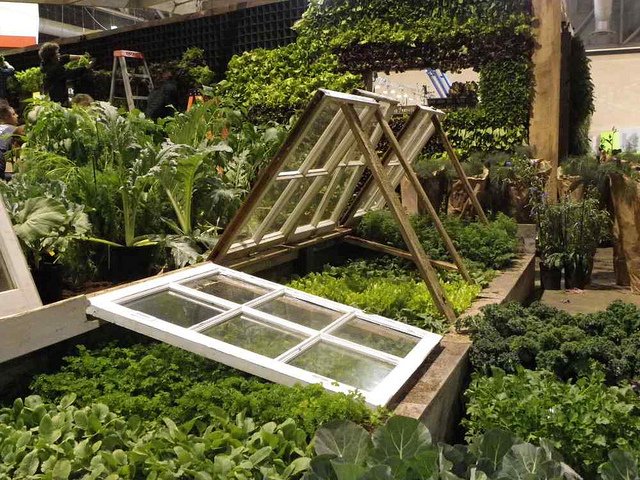
The Basics of Growing Food in the Winter
Having spent so much time in tropical environs, I fretted over having to think about seasons, in terms of temperature, when my wife Emma and I decided to give North Carolina a try. Suddenly, we are having to think about frosts much more than wet and dry season, and a bit more encouraging than expected, we are finding a new abundance that accompanies cooler places.
Going into our first autumn here, we are investigating the possibilities of four-season harvesting, and that means learning which plants can handle the chill and which ones are best left for next year. We are also becoming more knowledgeable about cold frames, hoop houses, and other methods for maintaining a little warmth without burning energy.
What has become apparent is that, without a doubt, growing fresh vegetables is possible year-round, even with winters that regularly dip into or stay below freezing temperatures. It doesn’t require a huge greenhouse or a lot of power, just some basic systems for keeping the frost off and a selection of the right kind of plants.
Keeping the Frost Off
Keeping the frost off of certain cold-tolerant plants will help extend their growing season, and this, of course, means changing the garden a little bit. Like the wet/dry tropics, which almost requires different beds—raised and sunken—for the wet and dry season, temperate climate gardens benefit from designs with frost in mind. There are several simple ways to do this, and in certain cultures, the winter garden is just an understood thing.
Using the sunny south-facing understory of tree lines is a possibility for extending the season, but it requires quite a specific set of circumstances and challenges, such as dealing with natural leaf fall mulching over the crops. Additionally, while these will provide a bit more warmth, plants are still subject to nearly the full force of outside temperatures.
- YouTube! Video: How to Build a Cold Frame to Extend Your Growing Season
Instead, cold frames and hoop houses seem to be the preferred methods, and these have the added benefit of trapping more heat as well. Cold frames are wooden frames that encircle a growing space, and they have hinged glass lids that allow the sun in but keep the cold out, preventing both frost and the ground beneath them from freezing. Hoop houses are a similar design concept, but they are generally plastic sheeting pulled tightly over hoops that span a planting space.
In any of these cases, a thick mulch does a lot of good, as it too protects the soil from freezing and provides additional warmth for the plants, all the while doing all the other things mulch does. In the cold frames and hoop houses, the warmth created by the decomposition helps to keep the air inside just that little bit warmer.
I’ve recently being reading Four-Season Harvest by Eliot Coleman, a year-round grower in Maine, and he believes that, once these simple measures are in place, it’s hours of sunlight, rather than temperature, that is the more limiting factor in a winter garden. Of course, that is taking into account that we are attempting to grow cold-hardy crops rather tomatoes and peppers.
Choosing the Right Crops
Adopting permaculture techniques for growing in any climate at any time of year insists that we choose appropriate plants for the situation. In this case, we are going to need plants that are well-suited for cultivating in cold temperatures. Opting to follow nature’s lead is what is going to prevent us from struggling to produce a crop and relying on a lot of extra inputs.
Winter gardens, then, are largely centered around dark, leafy greens, many of which actually improve in flavor, loosing some of their bitterness, when temperatures get frosty. Spinach and kale are two of the hardiest greens to grow, with chard, cabbages, arugula, lettuce, and endive being other familiar varieties that can survive in cold frames. Other possibilities include mache, collards, and claytonia, which are all super hardy greens that work for the winter. That’s ten varieties to choose from.

Many root vegetables are also cold hardy, and they do well in this setting. Plus, they provide some color and nutrient variety to meals. Carrots are one of the vegetables that are said to improve with the cold, becoming sweeter as the sugars naturally accumulate to act as a biological antifreeze. Even the green tops can survive and be used like parsley. Parsnips work similarly to carrots, and turnips, radishes and beets are three other roots to incorporate, all of which have edible greens as well. Now, we are up to fifteen crops.
The allium—onion family—is another viable option in the winter, and the members of this group have traditionally been used to thwart flus and colds, another wintertime concern. In this category, leeks are king, as they can be harvested throughout the season. With regards to others in the family, garlic, chives, and shallots can all provide onion-y sprouts from cold frames (Note: This will affect the underground, bulb growth), and winter onions are small, bunching onions that can be harvested during the winter, two to three months after a fall planting. That puts us at twenty vegetables growing.
Cruciferous vegetables aren’t only for dark, leafy greens, and they are certainly well suited for winter gardens. Two favorites that grow in the cold are broccoli and Brussels sprouts, and broccoli will continue producing new sprouts, after the head is harvested, into the snow. Cauliflower and kohlrabi are two more that can deal with a little frost, bringing the count to 24 different vegetables in the garden, not including different varieties of each.
Lastly, we have to make sure to keep some fresh herbs on hand, and while basil isn’t in the cards for the winter months, other herbs are poised to provide flavor for our dishes. Parsley, for one, can handle hard frosts, and sage—a perennial evergreen—can withstand frosty temperatures as well. There are winter varieties of thyme, and rosemary is a perennial evergreen, though it will need some frost protection. Mint, too, can continue to produce in a cold frame, and cilantro likes the winter cold over the summer heat. We are at 30 different crops now.
And, just to round out the list with some more possibilities, these can also be included. Peas are a nitrogen-fixer that prefers cold temperatures, and fava beans fix nitrogen and are verified cold-hardy. Sorrel, mizuna, and mustard are three more greens that can be on the list. Radicchio is another leafy veg but purple rather than green. Seriously, 35 different vegetables would hopefully be a variety large enough to get anyone through the winter.
Learning to Love the Idea of Winter

Moving from the tropics to a four-season climate with true, freezing winters has been a scary transition, and the thought of having to wear a coat, shoes, and long pants has been an adjustment. That said, gardening with the seasons now has us excited. It brings a new spin on diversity, and the thought of dishes changing throughout the year has us anxious to see the first winter pass.
Header: Courtesy of Charles Smith













In my zone 5 garden collards have proven to be the hardiest.
Great article! I have lived in subtropical and Mediterranean climates, and now I’m moving to a four-seasons area where I will have snowy winters for the first time. I loved all the great info for making the switch!
Great article- many thanks and wish you continued success.
Live between Melbourne , Australia and north Bali- so I understand the seasonal changes you speak of.
Fascinating that there are so many crops to grow in the cold- snow not here but cooler winters in Melbourne
Inspirational
Cheers at 35 degrees celcius today !!